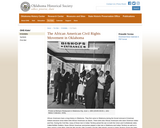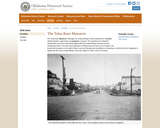
Video and Podcast Links to the 1921 Tulsa Race Massacre
- Subject:
- U.S. History
- Material Type:
- Activity/Lab
- Author:
- Amit
- Date Added:
- 06/01/2021

Video and Podcast Links to the 1921 Tulsa Race Massacre

African Americans have a long history in Oklahoma. They first came to Oklahoma during the forced removal of American Indians because some tribes held African Americans as slaves. There were also African Americans who were American Indian and free. During the Civil War, many of these men in Indian Territory joined the war on both the Union and Confederate sides. Called Buffalo Soldiers, these African American servicemen played a vital role in Oklahoma and Indian Territory as well as in other regions of the West. Both the 9th and the 10th Cavalries and the 24th Infantry served in Indian Territory during the latter nineteenth century. Stationed at Fort Gibson, the 1st Kansas Colored Volunteers Infantry Regiment (later supplemented with the 2nd Kansas) fought at Cabin Creek and at the pivotal engagement of Honey Springs in July 1863. After the Civil War ended in 1865, all of the slaves in the United States, including Indian Territory, were freed. Known as freedmen, many continued living among the Indians.

The Woodson Center Curriculum provides lesson plans, slide shows, and readings of significant moments in Black American history. Many of the biographies are of Black Americans often ignored by textbooks. The project seeks to highlight examples of excellence, resilience, and perseverance, in the Black community and among Black individuals while battling the realities of racism.

This lesson plan introduces learners to the historical facts of Black Wall Street and the Tulsa Race Riots of 1921, using primary resources from the Library of Congress.

The Tulsa Race Massacre challenges our understanding of early Oklahoma as a frontier offering freedom, opportunity, and progress to anyone. The experiences of individual Oklahomans may have occasionally aligned with that understanding, but that occurred infrequently at best. The lives and experiences of Oklahomans are much more complex. The events that transpired on the night of May 31 and the following day are difficult to comprehend, and the fact that it happened is frightening. We have a responsibility to face this chapter in order to know our history.